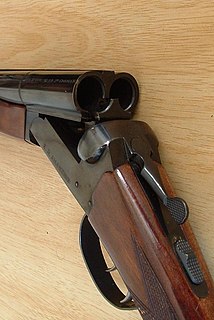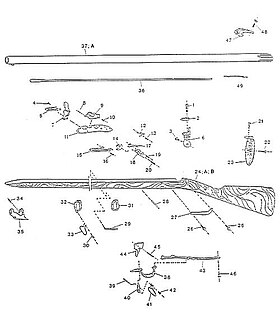
The percussion cap or percussion primer, introduced in the early 1820s, is a type of single-use percussion ignition device for muzzle loader firearm locks enabling them to fire reliably in any weather condition. This crucial invention gave rise to the cap lock mechanism or percussion lock system using percussion caps struck by the hammer to set off the gunpowder charge in percussion guns including percussion rifles and cap and ball firearms. Any firearm using a caplock mechanism is a percussion gun. Any long gun with a cap-lock mechanism and rifled barrel is a percussion rifle. Cap and ball describes cap-lock firearms discharging a single bore-diameter spherical bullet with each shot.

In firearms terminology, an action is the functional mechanism of a breech-loading firearm that handles the ammunition cartridges, or the method by which that mechanism works. Actions are technically not present on muzzleloaders, as all those are single-shot firearms with a closed off breech with the powder and projectile manually loaded from the muzzle. Instead, the muzzleloader ignition mechanism is referred to as the lock.

Flintlock is a general term for any firearm that uses a flint-striking ignition mechanism, the first of which appeared in Western Europe in the early 16th century. The term may also apply to a particular form of the mechanism itself, also known as the true flintlock, that was introduced in the early 17th century, and gradually replaced earlier firearm-ignition technologies, such as the matchlock, the wheellock, and the earlier flintlock mechanisms such as snaplock and snaphaunce.

The Charleville musket was a .69 caliber standard French infantry musket used in the 18th and 19th centuries. It was made in 1717 and was last produced during the 1840s. However, it still saw limited use in conflicts through the mid-19th century.

A wheellock, wheel-lock or wheel lock is a friction-wheel mechanism which creates a spark that causes a firearm to fire. It was the next major development in firearms technology after the matchlock and the first self-igniting firearm. Its name is from its rotating steel wheel to provide ignition. Developed in Europe around 1500, it was used alongside the matchlock and was later superseded by the snaplock (1540s), the snaphance (1560s) and the flintlock.

A snaphance or snaphaunce is a type of firearm lock in which a flint struck against a striker plate above a steel pan ignites the priming powder which fires the gun. It is the mechanical progression of the wheellock firing mechanism, and along with the miquelet lock and doglock are predecessors of the flintlock mechanism.

The flintlock mechanism is a type of lock used on muskets, rifles, and pistols from the early 17th to the mid-19th century. It is commonly referred to as a "flintlock", though that term is also commonly used for the weapons themselves as a whole, and not just the lock mechanism.

The lock of a firearm is the mechanism used to initiate firing. It is a historical term, in that it generally refers to such mechanisms used in muzzle-loading and early breech-loading firearms. Side-lock refers to the type of construction, in which the individual components of the mechanism are mounted either side of a single plate. The assembly is then mounted to the stock on the side of the firearm. In modern firearm designs, the mechanism to initiate firing is generally constructed within the frame or receiver of the firearm and is referred to as the firing or trigger mechanism.

A snaplock is a type of lock for firing a gun or is a gun fired by such a lock.

The Puckle gun was a primitive crew-served, manually-operated flintlock revolver patented in 1718 by James Puckle (1667–1724), a British inventor, lawyer and writer. It was one of the earliest weapons to be referred to as a "machine gun", being called such in a 1722 shipping manifest, though its operation does not match the modern use of the term. It was never used during any combat operation or war. Production was highly limited and may have been as few as two guns.

Joint Combined Exchange Training or JCET programs are exercises designed to provide training opportunities for American Special Forces by holding the training exercises in countries that the forces may one day have to operate in, as well as providing training opportunities for the armed forces of the host countries. Typically, each JCET program involved 10–40 American special forces personnel, though can sometimes involved up to 100. The United States Congress permitted the use of funds from the military budget to be used in overseas training such as JCETs in 1991, providing that the Secretary of Defense submits to Congress annually a report on overseas training activities.

Operation Juniper Shield, formerly known as Operation Enduring Freedom – Trans Sahara (OEF-TS), is the military operation conducted by the United States and partner nations in the Saharan and Sahel regions of Africa, consisting of counterterrorism efforts and policing of arms and drug trafficking across central Africa. It is part of the Global War on Terrorism (GWOT). The other OEF mission in Africa is Operation Enduring Freedom – Horn of Africa (OEF-HOA).
The Salafist Group for Preaching and Combat, known by the French acronym GSPC, was an Algerian terrorist faction in the Algerian Civil War founded in 1998 by Hassan Hattab, a former regional commander of the Armed Islamic Group (GIA). After Hattab was ousted from the organization in 2003, the group officially pledged support for al-Qaeda, and in January 2007, the group officially changed its name to the "Al-Qaeda Organization in the Islamic Maghreb" (AQIM).

A doglock is a type of lock for firearms that preceded the 'true' flintlock in rifles, muskets, and pistols in the 17th century. Commonly used throughout Europe in the late seventeenth century, it gained popular favor in the British and Dutch military. A doglock carbine was the principal weapon of the harquebusier, the most numerous type of cavalry in the armies of the Thirty Years' War and English Civil War era. Like the snaphance, it was largely supplanted by the flintlock.

The Belton flintlock was a repeating flintlock design using superposed loads, conceived by Philadelphia, Pennsylvania, resident Joseph Belton some time prior to 1777. The musket design was offered by Belton to the newly formed Continental Congress in 1777. Belton wrote that the musket could fire eight rounds with one loading, and that he could support his claims "by experimental proof." Belton failed to sell the musket to Congress, and later was unable to sell the design to the British Army a year after the American Revolution. There are no records that indicate that the gun was ever supplied, and it is uncertain if or how exactly the Belton improvement operated.
The Cookson flintlock rifle, a lever-action breech-loading repeater, also known as the Cookson gun, is one of many similar designs to make an appearance on the world stage beginning in the 17th century. The Victoria & Albert Museum in London has a Cookson Gun, dating to 1690. According to the museum, John Cookson made several repeating guns based on this system. He signed one 'Fecit Londini', which suggests he was a London maker. Another John Cookson, who was also a gunmaker, is known to have worked in America. He is recorded in Boston, Mass. between 1701 and 1762. In 1756 he advertised repeating firearms firing nine shots in the local paper, the Boston Gazette. It is probable that he was related to the John Cookson who worked in London.
Operation Flintlock may refer to:
In firearms and artillery, the primer is the chemical and/or device responsible for initiating the propellant combustion that will push the projectiles out of the gun barrel.












